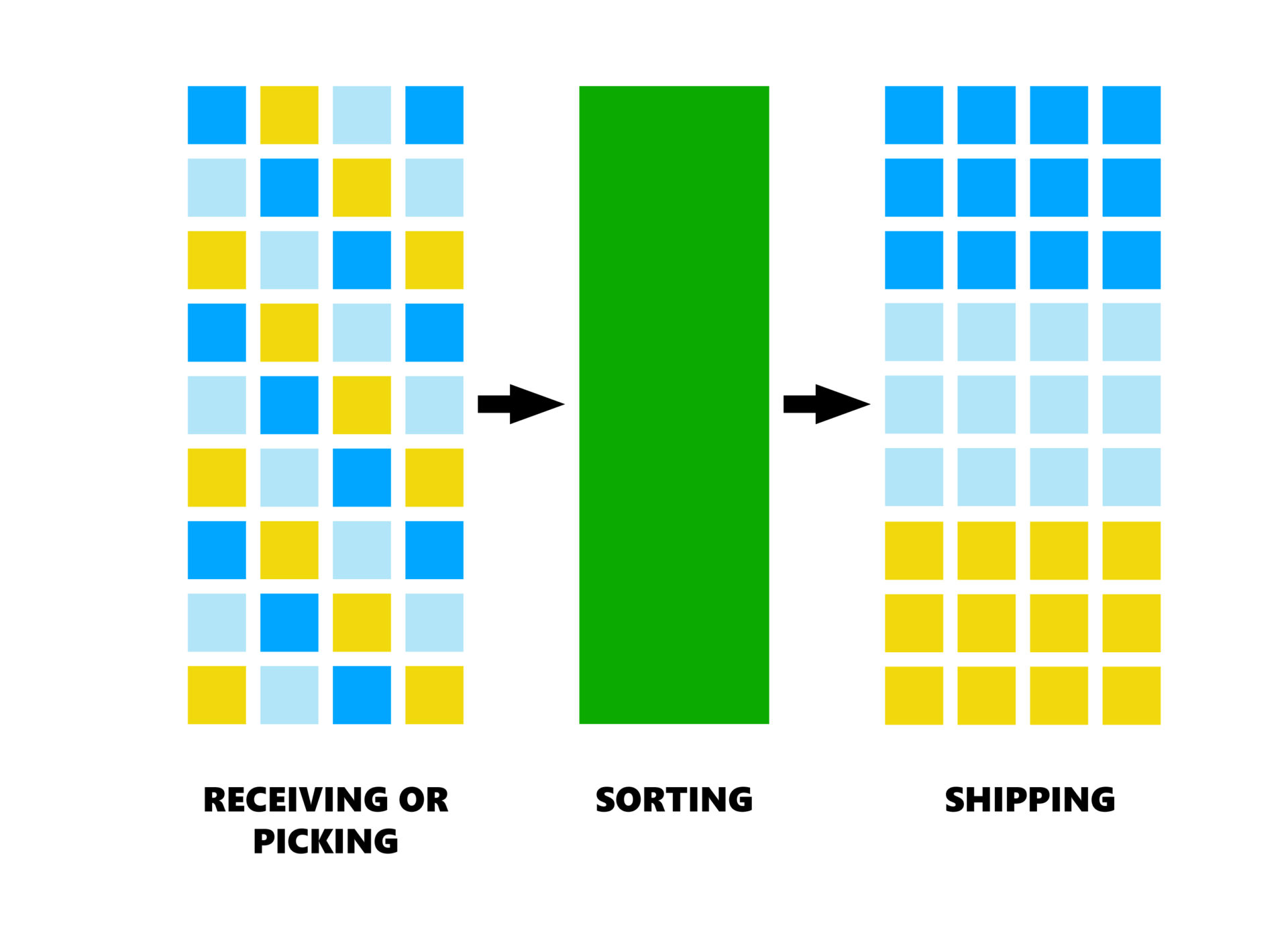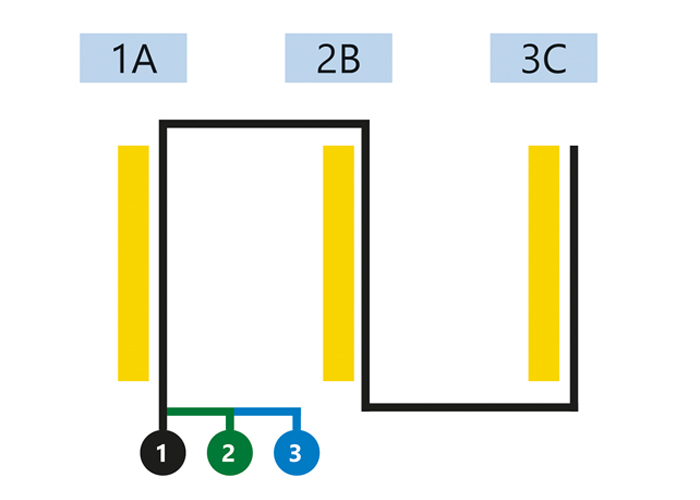Introduction to sorting in retail and e-commerce
Home » Introduction to sorting in retail and e-commerce
Sorting systems come in a huge variety. It is easy to get lost in the range of sorting systems that are available in the market today. Sorters go by many names: flat sorters, vertical sorters, fashion sorters, bomb-bay sorters, and many more. So what is a sorting system and how do you determine which type of sorting system is the right fit?
In this article, I will explain the basics of what sorting systems do, what typical applications there are in retail, 3PL, e-commerce, or omnichannel logistics, and when you should consider investing in one. If you have a good understanding of sorting and want to jump forward in selecting the right sorter, you should read the following blog post: the right tool for the job: finding the right sorter for your process
What is a sorting system?
Sorting systems are used to sort items in warehouses or distribution centers based on their destinations. Random flows of items are consolidated for shipping (outbound) or storage (inbound or returns). Sorting parameters depend on the type of company or application within the supply chain. Below you'll find a diagram of a typical sorting system application within the retail, 3PL or e-commerce outbound sorting process.

Manual, semi-automatic or automatic sorting
Sorters come in a large variety. Automatic sorters range from conveyor-based sorters like the cross-track sorter to carrier-based sorters like the slide tray sorter or bomb-bay sorter. Based on aspects like the required capacity and the available budget, the choice might be made to select a manual sorting system or (semi-)automatic sorting system. The full list of sorter types is endless and constantly evolving, but the most common types include:
About the author
Denny van Veen is Marketeer at Equinox MHE. He has been working in marketing for over ten years and has worked for several system integrators. The past few years at Equinox he has gained a lot of insight in the retail, e-commerce, and parcel market by interviewing customers, researching market trends, and visiting customer sites.
(Semi-)automatic sorting
- Split tray sorter (bomb-bay sorter)
- Slide tray sorter
- Vertical sorter (LR-sorter)
- Cross-track sorter
- Shoe sorter
- Tilt tray sorter
- Pop-up sorter
- Pusher sorter
Text continues below the image
Manual sorting
Similarities in sorting
All sorters do have one thing in common: the process they support and the steps they take to fulfill that process. It starts with gathering the items that need sorting. The items are picked from the warehouse or inventory and transported to the infeed zone of the sorter. There, the items are identified and fed into the sorter, a process that can be executed manually or automatically.
The final stage of the sorting process is the sorting of the items to a specific destination based on the predefined parameters. Typical sorter exits include cartons, totes, roll containers, yorks, or trolleys.
How sorting systems improve picking efficiency
When moving from manual to automatic sorting, most typical applications use batch picking to replace order picking. Order picking activity is built upon the picking of single orders. The items from one location are picked for a single order. If an SKU is required for multiple orders, the SKU location is revisited for each order.
Batch picking allows operators to pick a group of orders, also known as a pick wave. Each SKU is visited once to pick for all orders. The sorter is used to break down the batch into individual orders. See the graphic below for an overview of both picking methods. Batch picking is a more efficient way of picking. It saves your operators time and drastically reduces the distance they have to walk.
Text continues below the image

Manual infeed: operators put the items directly in the sorter tray.

Automatic infeed: operators put the items on a belt from which the items are fed into the sorter.
Single item picking

| Order picking | |||
| Order | SKU | Quantity | Location |
| 1 | A | 8 | 1A |
| B | 3 | 2B | |
| C | 6 | 3C | |
| 2 | A | 2 | 1A |
| C | 4 | 3C | |
| 3 | A | 8 | 1A |
| B | 4 | 2B | |
| C | 7 | 3C | |
Batch picking diagram

| Batch picking | |||
| SKU | LOC | Quantity | Order |
| 1A | 1A | 18 | 1 |
| 2 | |||
| 3 | |||
| B | 2B | 7 | 1 |
| 3 | |||
| C | 3C | 17 | 1 |
| 2 | |||
| 3 | |||
When to consider a sorting system?
There are a number of reasons to consider automation of the sorting process. The most common causes we recognize are:
Increase throughput or efficiency If growth is expected, an increase in throughput is required. With manual sorting, the increase in throughput is directly related to the increase in personnel. Sorters enable an increase in throughput without an equal increase in workforce. Companies that are facing growth can therefore benefit from automation. By purchasing a sorter the throughput can be increased with a limited amount of additional personnel. Reduce errors by automating repetitive tasks Sorters and automation in general also reduce the errors made in warehouses. When executing repetitive tasks, people are known to make mistakes. It is easy to let your mind wander and pay less attention to detail. Even the most experienced employees make mistakes, that’s human nature after all. However, mistakes take time and money to fix. Companies facing a high number of errors in their sorting process could improve their successful sorting rates by automating the process. This not only improves your accuracy, but frees up valuable time that can be spent on activities that add more value to your product. Improve ergonomics The distance employees need to walk with manual order picking is huge. By implementing a sorter, this can be cut down drastically and the physical load of employees can be greatly reduced. If we take the picking example below we can compare the distance traveled for 3 orders. By using batch picking instead of order picking the distance traveled is cut back to one-third. Automation helps you face labor shortages The labor shortage has been becoming increasingly relevant over the past years. Companies are having difficulties filling their vacancies. To stimulate continuous growth, automation could help increase throughput without the need for additional personnel. Additionally, the satisfaction of personnel increases. Automation relieves them of repetitive and labor-intensive tasks. Personnel will be more productive and make fewer work-related mistakes. Satisfied personnel will decrease staff turnover.
Every process is unique
Hopefully, this article has provided you with some pointers to review automation through sorting. These are based on lessons learned and frequently asked questions. However, every customer and process is unique, and therefore there is no one size fits all solution when it comes to sorters.
That’s why we provide a quick scan, consisting of a visit to your distribution center and an interview to find out your specific goals. This process takes approximately 1,5 hours. After our visit, we provide a report that outlines possible solutions for your unique logistic operation. Contact our experts for more information about this service.

